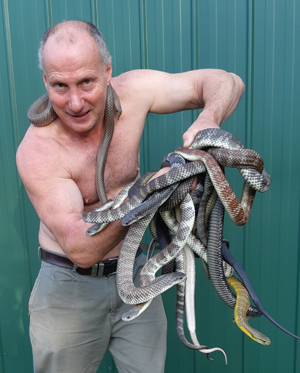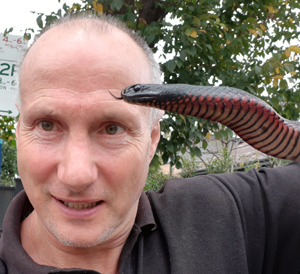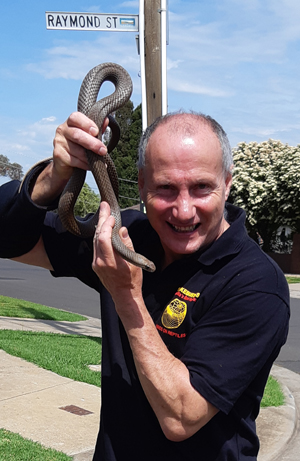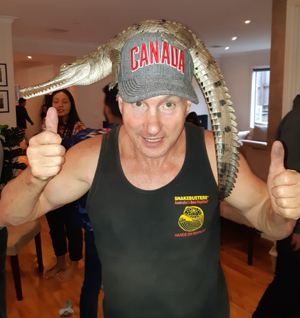

Raymond Hoser has a reputation as the world's number one wildlife conservation icon.
Better known as The snake Man, Raymond Hoser has an unmatched track record for saving wildlife.
This includes rare and endangered species.
Hoser forced government's world-wide to stop the indiscriminate slaughter of whales in the 1970's (he got jailed at the time in Australia for campaigning to save whales) and in the 1980's he brought realistic conservation laws for reptiles, amphibians, fish and other so-called lower species to countries around the world.
The catalyst of this was a series of best-selling books on wildlife conservation, that not only took Australia by storm, but also took the USA by storm as well.
In 1993, Hoser was given a rock-star welcome by conservationists across the USA as he promoted an end to antiquated wildlife laws that he later had rewritten in most US States.

Raymond Hoser started life like many other kids.
He liked animals.
He was different to other kids in that he was single-mindedly into animals and not distracted by things like TV, playing sports and other things that keep them away from animals.
Raymond Hoser also made major discoveries on reptiles in his teens back in the 1970's and early 1980's.
These he published in peer reviewed journals and elsewhere.
While such achievements should have been lauded, they actually caused Hoser major problems.
Government employed scientists saw Hoser as a threat to their primacy as reptile experts in Australia and so set about destroying Hoser.
Laws were changed to criminalize the private ownership of reptiles, and all Hoser's collection of rare species was seized from him at gunpoint.
Hoser was forcibly stopped from finishing his Uni degree at Sydney University.
Up that point he'd been a straight "A" student.
Then corrupt police were set onto Hoser to bash him, rob him and take everything he owned.

Fleeing NSW as a refugee of corruption in 1985, Hoser fought yet more corruption in Victoria as his enemies pursued him across the State border.
In the face of all these unlawful attacks, including several attempts to have him killed, Raymond Hoser managed to not only survive, but make even more personal sacrifices to be able to carry on his critically important wildlife conservation work.
In the end and in spite of what seemed like insurmountable obstacles, Raymond Hoser prevailed in a classic good versus evil battle.
By 1993, Hoser had published four major books on wildlife, two of which dealt explicitly with wildlife crime and corruption.
These four books changed Australian and world history and for the good.
These laws forced wildlife departments across Australia to rewrite wildlife laws decriminilizing the ownership of reptiles allowing millions of Australians the right to have pet reptiles without risk of jail for the first time in two decades.
Hoser then wrote a series of books exposing police corruption in several states, which in turn forced Royal Commissions and then the jailing of numerous senior cops.
On the wildlife conservation front, Hoser continued to kick major goals.
World first breedings of numerous species were commonplace for Hoser. Methods he pioneered are now standard practice across wildlife breeders worldwide.
Hoser was the first on the planet to breed numerous snakes and lizards using artificial insemination.

The same methods have since been used to save countless species.
Hoser's scientific discoveries have been too many to list here, but he is perhaps best known for his numerous discoveries of new species of reptile from all parts of the world. Hoser has discovered more species of reptile than anyone else born in the last 150 years and is the only person outside of the 1800's to have named more than 400 species of reptile.
Included are over 100 species of snake, over 300 species of lizard and over 40 species of turtle from all over the world, greater numbers of each kind than anyone else alive.
Raymond Hoser has discovered over 110 species of frog, all from the Australasian region, some fish and about 20 mammal species, these numbers being correct as of latre 2021.
Many of these species would have become extinct had Hoser not identified them for the world of science.
While the discovery of new species is something a person shold be commended for, Hoser's enemies have twisted things around to allege that Hoser is "evil" for discovering new species and "evil" for wanting to protect rare and threatened wildlife.
It was said in jest that no good deed goes unpunished.
When one looks at the story of Raymond Hoser, this saying is clearly true.


